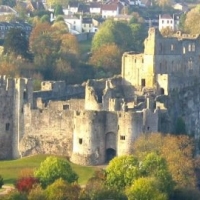Chepstow - The Gateway to The Wye Valley
Chepstow is a beautiful historic market town situated in the rural county of Monmouthshire. In medieval times it became the largest and most important port in Wales, while today it has a fantastic array of attractions to keep visitors and locals busy through the changing seasons.
The county of Monmouthshire boasts the Wye Valley Area of Outstanding Natural Beauty, Offa’s Dyke, the Black Mountains, and parts of the Brecon Beacons National Park. It is also scattered with historic attractions, including Chepstow, Raglan, & Abergavenny castles, and Tintern Abbey. Its main towns of Chepstow, Abergavenny, Usk and Monmouth are known for their independent shops and locally produced food – particularly at the Abergavenny Food Festival, which attracts thousands of people each September.
A bustling border market town, Chepstow is the gateway to the Wye Valley. Spend some time exploring the winding back streets with a variety of shops, restaurants and cafés, and take in the old town walls and the 15th Century gatehouse.
The first stone castle to be built in Britain following the Norman Conquest still stands guard over the River Wye as it nears its confluence with the Severn Estuary. Chepstow Castle is the first datable stone castle in Wales, built in 1067 . From its origins during the Norman times, to its bloody siege in the Civil War 600 years later, it is central to Chepstow's history. Positioned on limestone cliffs with terrific views over The Wye there are have been various extensions to the Castle over the centuries until it fell to siege by Oliver Cromwell in the 17th century Civil War. The Castle, and the town that grew up around it, has been an important port and market centre ever since. It is now protected by CADW Welsh Historic Monuments, who act as custodians. It is open daily to visitors.
There are regular race meetings at nearby Chepstow Racecourse, home of the Welsh National, which is situated within the grounds of historic Piercefield Park. Famous views from the Wye Valley Walk section from Chepstow lead you along the Piercefield Walks and stunning viewpoints such as The Alcove and Eagles Nest.
Chepstow’s past includes shipbuilding and salmon fishing, the export of timber and oak bark and the import of wine. In the 18th century the town became popular with visitors following the Wye Tour, Britain’s first tourist trail, which attracted the wealthy and the idealistic in search of the Picturesque. Amongst them were the artists Turner and Sandby and the poet Wordsworth.
The Chepstow iron bridge which connects Chepstow to Gloucestershire was built by John Rennie in 1816 and was constructed in cast- iron. This bridge was an important improvement in travel for local businesses and residents and it continues to provide valuable access across The Wye. Today it provides a picturesque view of the Town and a delightful place to spend a sunny afternoon watching the World go by.
Chepstow Museum tells the story of the Wye Tour, and is a short walk from the Regency iron bridge over the Wye. Until the Severn Road Bridge opened in 1966, this provided the most direct road access from Bristol to South Wales.
Today, the two Severn crossings at the edge of Chepstow are regarded as amongst the most iconic and recognisable sights in southern Britain.


